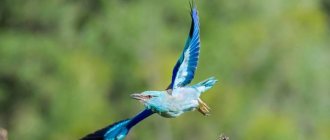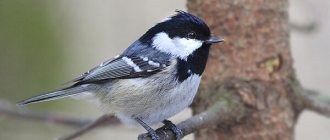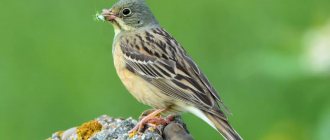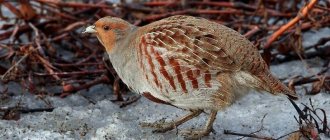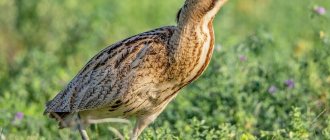- Wild animals
- >>
- Birds
The finch is the most common bird of the passerine order. Outwardly, it is actually very similar to an ordinary sparrow, but unlike it, it is capable of changing color depending on the time of year. There are a great many varieties of finch and in this article we will talk about the most prominent representatives of this family, we will give a lot of interesting facts about the life of the bird and its unique features.
Description of the bird
The finch has a small body, the dimensions of which do not exceed 14 cm in length. Weight is 17-20 grams. The plumage on the breast is orange, but the back and neck change color - in winter these parts are gray-brown, and in summer they become black. The beak has a wide shape, although its size is small. It is painted black. The paws are gray and very tenacious, they have sharp claws. Males always have brighter colors than females.
Finches belong to the order Passeriformes, to the family of finches, to the genus of finches, and to the species of finches.
— Advertising —
Birds sing well, but their song is quiet and calm when they are sitting, but in flight they can make sharper sounds.
Video
43 Free photos of Bittern
We invite you to watch several videos filmed by experienced poultry farmers talking about the characteristics of Legbar chickens, the features of their keeping and breeding:
About the author:
Found a mistake? Select the text with the mouse and click:
Ctrl + Enter
Do you know that:
A new product from American developers is the Tertill robot, which weeds weeds in the garden. The device was invented under the leadership of John Downes (creator of the robot vacuum cleaner) and works autonomously in all weather conditions, moving over uneven surfaces on wheels. At the same time, it cuts off all plants below 3 cm with the built-in trimmer.
Behavior and diet
Finches are very interesting birds that are very different from each other. This is especially noticeable if we draw an analogy between their subspecies. There are birds that adapt to any weather conditions, and there are lovers of warmth - nomads to the South.
Interestingly, finches can nest in pairs and prefer living with a flock.
— Advertising —
The location for the home is chosen carefully – shrubs are ideal. Birds love to hide their chicks from all prying eyes.
Insects dominate the diet of finches. Birds prefer real hunting - they catch small animals while flying. By the way, finches are acrobats that can perform aerial somersaults and flutter funny.
Lifestyle
The streamlined body shape and strong wings allow the bird to fly quickly and confidently. During a hunt, the finch can even perform a mind-blowing maneuver to catch an insect that suddenly appears in its field of view in flight. Finches living side by side with humans can gradually get used to it and stop being afraid of people, feeding from feeders.
Having climbed higher - to the top of a tree or the cornice of a tall building, song finches loudly sing beautiful songs. This melody sounds like a combination of trills and whistles, surprising listeners with the variety of sounds.
Nowadays, finches can be found as pets. Of course, an acceptable option for keeping a finch in captivity is only a bird that has lived in such conditions since birth.
Finches are perky, quick-tempered, grumpy, although, in essence, they are extremely sociable and funny. They can be aggressive towards other birds if kept in the same cage. Finches are very shy and difficult to tame.
Distribution and habitats
Finches inhabit Scandinavia, Russia, Europe: Norway, Oslo, Sweden, Finland, Estonia, and some species choose the Azores and South Africa.
They build their nests near forests, parks, and vegetable gardens. Finches are not afraid of humans, so they can easily nest near human private houses if they are located near rivers or mixed forests.
Breeding
Owners of individual farmsteads and farmers who dream of having purebred Legbars often face the problem of purchasing high-quality hatching eggs. As a rule, they are purchased from poultry breeders (Russian or foreign) or from Genefond LLC (Sergiev Posad, Moscow region). Unfortunately, even cooperation with the most well-known suppliers does not exclude the possibility of receiving incubation material that has low fertility rates.
Breeding legbars is associated with high costs and difficulties in acquiring high-quality hatching eggs
There are a number of techniques that reduce risks when making purchases of this kind. Experienced poultry farmers advise:
Purchase hatching eggs from private domestic breeders, having previously visited their farms to assess the living conditions and appearance of the parental individuals. It is necessary to pay attention not only to the breed characteristics of the bird, but also to such characteristics as the condition of the toes of laying hens and males
It is important that the rooster has a straight, erect comb of a characteristic bright red color (if the comb is pale or hangs to one side, most of the eggs from such a rooster will be unfertilized). Try to order hatching eggs from European breeders with a solid reputation. This is more expensive, but the reliability of such products is usually higher. Buy not eggs, but chicks (day old or slightly grown up). In this case, it is also necessary to evaluate the condition of the parents, as well as the compliance of the color of the chicks with breed standards.
Raising legbar chickens is not particularly difficult. Babies need to be provided with regular proper feeding and maintenance in optimal temperature conditions. Then the chicks quickly fledge and grow without causing any problems to the owner.
Migratory or wintering
The finch is a migratory bird. Usually leaves the nest with the onset of autumn and returns in April - May, in different regions, this process differs. For the winter it flies to southern Europe, Asia - Turkey, Iran, Turkmenistan, Japan, China.
Soundtracks
From the movie Spotlight From the movie Van Helsing From the TV series The Vampire Diaries From the movie Scouts vs. Zombies From the Mission: Impossible movies From the movie The Hunger Games: Mockingjay. Part 2OST 'The Light in the Ocean'OST 'The BFG' from the film 'New Year's Party' from the film 'Schindler's List' OST 'The Transporter' From the film The Jungle Book from the series 'Method' From the film Bodyguard From the series Betrayal from the film Mysterium. Darkness in a Bottle from the film 'Passengers' from the film Silence From the TV series Kitchen. Season 6 from the film 'Reckoning' From the film Ant-Man from the film The Invitation From the film The Maze Runner 2 from the film 'Hammer' From the film 'Incarnation' From the film Savva. Heart of a Warrior From the series Is It Easy to Be Young from the series 'Olga' From the series The Chronicles of Shannara From the film The Best Day From the film Neighbors. On the WarpathMusic from the series "Island"From the movie YoganutsFrom the movie CriminalFrom the series SupernaturalFrom the series La Dolce VitaFrom the movie A Hologram for the KingFrom the movie The First Avenger: Civil WarFrom the movie BonesFrom the movie A Love Out of SizeOST 'Deepwater Horizon'From the movie Correspondence from the movie 'Phantom Beauty'The meeting place cannot be changedOST "Genius" from the movie 'Pretty Woman' From the movie Alice Through the Looking Glass From the movie 1+1 (The Untouchables) From the movie Me Before You From the movie 'Hidden Figures' From the movie The Calling From the series 'Westworld' From the games in the 'Bioshock' series Music from the anime " Black Butler" from the film 'American Pastoral' From the film Tarzan. LegendFrom the movie Beauty and the Beast 'Artificial Intelligence. Unlimited access"Men in Black 3" from the movie 'Planetarium'From the movie The WalkFrom the series OutlanderFrom the series Elementaryfrom the series 'The Dark Side of the Moon'From the movie WarcraftFrom the movie Louder Than Bombsfrom the cartoon 'Beast Boy'From the movie BrooklynFrom the movie The Big ShortFrom the movie Enchantedfrom the movie DestructionOST " A complete mess"OST "Free State of Jones"OST The Lights Go OutFrom the series SoldiersFrom the series Roof of the WorldFrom the movie The Neon DemonFrom the movie Moscow Never SleepsFrom the movie Jane Gets a GunFrom the movie Guardians of the Galaxyfrom the movie 'Sos, Santa Claus or It'll Come True'OST 'Miss Peregrine's Home for Peculiar Children 'From the game Contact WarsFrom the Movie AmelieFrom the movie Now You See Me 2OST Ice Age 5: Collision is inevitableFrom the movie Out of the DarkFrom the movie Colony Dignidadiz from the movie 'Wonderland'Music from the series 'The Color of the Bird Cherry'From the movie Zoolander 2 from the Harry Potter movies From the movie Divergent, Chapter 3 : Behind the wall from the cartoon 'Monster in Paris' from the cartoon 'Storks'From the film The BoxFrom the film SomniaFrom the series The Walking DeadFrom the film The ChoiceFrom the series The Wren is a songbirdIndependence Day 2: ResurgenceFrom the series Magnificent Centuryfrom the film 'A Spy and a Half'from the film High LifeFrom the series Peaky Blinders
Kinds
In nature, there are several subspecies of finches. Often, all, without exception, have a pronounced sexual dimorphism, which is observed in the brightness of the plumage of males.
canary finch
The bird lives from the Himalayas to the southern part of the Sahara. Body length 10-12 cm, weight 13-15 grams. It has a thick, short beak, dark gray in color. By the way, the canary finch is the smallest bird of the finch family, common in Europe.
The bird has a bright and interesting coloring, the predominant color is green, the wings are brown, with small specks located on the back and sides in males, and in females this pigment is located on the breast.
The bird produces two clutches throughout the year, each consisting of three to five eggs, which are incubated by one female.
It must be remembered that there are several subspecies of the canary finch, which differ in radically different colors.
Mozambique finch
A subspecies of the canary finch is the Mozambique finch. It lives in South Africa, Tanzania, Zimbabwe, and Mozambique. It has a more saturated color in which bright green and yellow predominate. Many local residents keep this subspecies in their homes.
The Mozambique finch nests in savanna, forests, and parks. It feeds on small seeds, larvae, fruits, and pulp.
Snow finch
He is also an alpine or snow sparrow. It lives in the Alps, the Balkans, the Caucasus, the Carpathian Mountains, and Middle and Central Asia. This subspecies leads a predominantly sedentary lifestyle.
The nest is built high in the mountains, or in rocks, while maintaining the principle of settling in flocks, and not in pairs. It jumps jerkily and quickly on the ground.
The colors of the plumage of these birds are dominated by white and light gray on the lower part of the body and brown in the area of the wings. There is a pronounced dark spot on the neck. Sexual dimorphism in a couple is very weakly expressed and can only manifest itself in mating behavior.
The beak is slightly narrower than that of the canary subspecies, and is yellow underneath. The bird sings loudly and melodiously.
The diet includes seeds of alpine grasses, cereals, as well as insects, beetles, and spiders.
Red-capped finch or king
The bird lives in the highlands of the Caucasus, Turkey, Pakistan, and Iran. Closer to winter, he moves to India, on the coast of the Aegean Sea.
Due to its unusual plumage, the bird is often kept in captivity; in addition, it sings well. The colors are predominantly black and gray; there is a red spot on the head that resembles a mohawk. Less commonly, red or orange speckles are present on the wings and breast
The bird feeds on small animals, as well as millet and seeds.
Yellow-bellied finch
Inhabits South Africa, Angola. The bird's favorite place to build a nest is old bushes and thickets.
The plumage of this subspecies is characterized by the presence of bright yellow and green colors. There may be brown and white spots and stripes on the wings, but the belly is always completely yellow. The iris of the eye is black. The beak is medium in size, but powerful in width. It is painted light brown. Sexual dimorphism between the female and the male is pronounced and consists in a calmer coloring of the female - gray color predominates in it, without bright spots. Body length 13-14 cm, weight up to 17 grams.
Galapagos finch
It is also called Darwinian and lives in a group of islands in the Pacific Ocean - the Galapagos Islands. The bird is endemic and has about seven subspecies. They received their second name due to their ancient origin - more than 2.5-3 million years ago. Charles Darwin himself studied finches from the point of view of evolutionary biology.
Usually these finches do not reach more than 20 cm in body length, but they are very different from each other in the shape of their beak and plumage. Let's take a closer look at some of them.
Large cactus finch
Endemic to the Galapagos Islands. A notable feature of the bird is its large beak. Typically, male cactus finches have black plumage, while females have shades of brown and white. Their beak is not as dark as that of males. Interestingly, this subspecies lives in cacti and is not at all afraid of being stabbed. Birds feed on seeds and flowers from cacti and crickets.
Sharp-billed finch
This is a predatory, carnivorous bird that lives on the meat of other animals. Birds are also endemic and inhabit Darwin and Wolf Islands.
Sharp-billed finches are bloodthirsty - when hunting their prey, they come up with whole tactics, and when the prey is in their power, they begin to peck at it until blood begins to flow from the victim. The fact is that this subspecies of finches thus quenches thirst, because drought reigns on the islands. They also do not neglect theft - they steal eggs from the nests of other birds and roll them on the ground until they break them.
Medium Ground Finch
This is a very useful bird, it cleanses the skin of animals such as elephants and turtles.
This bird has a strong and large beak with an orange tip. The plumage is black, as are the eyes.
The bird prefers seeds and berries, and less often eats insects.
Lesser Ground Finch
This bird is the smallest of all the subspecies that live on the islands - only 10-11 cm in body length. They are also endemic.
They inhabit arid forests and bushes, sometimes nesting near mountains, where they remain for the entire mating season. It feeds on berries, leaves, flowers.
Birds destroy harmful insects from the bodies of other animals.
Mangrove Tree Finch
This is a very rare subspecies, endemic. The birds inhabit Isabella Island and are under protected status. The population of this species is 60-140 individuals.
The mangrove finch is gray and inconspicuous in color; its belly has olive plumage. The beak is black, large, and the eyes are round. The wings and tail of this subspecies have a rounded shape.
The bird gets food in a very interesting way - using branches in its beak, it pokes around in the ground in search of spiders or small bugs.
Woodpecker Woodfinch
A very interesting and funny bird that obtains food using a cactus thorn, which it skillfully wields in its beak.
The bird's body length is 15 cm, weight - up to 20 grams.
Patriarchy reigns in the family of thrush finches - only the male maintains the nest, and both parents are involved in incubation. The chicks are born after 12-13 days.
The bird is also endemic.
Gray finch
He has a powerful voice and great singing talent. Inhabits Africa, where it is very popular among the locals. People also call him noble. The color is gray, inconspicuous, sexual dimorphism is not expressed in any way.
Damara-alario
A very bright and beautiful bird from the finch family. But, unfortunately, their population only decreases over the years. Inhabits South-West Africa. It got its name from the Damara tribe in whose territory it lives.
Alario
A songbird that was discovered by scientists in the 18th century. The plumage contains: black, red and brown colors. The bird has a calm character, is not shy and sings well.
Links
- Vertebrates of Russia: Finch
- Reel on the “ecosystema” website
He is Yurok, Sarka, Yur, Khahe, etc. It lives everywhere except the Far North and the Amur region. This is a migratory bird.
In the spring, the adult male finch has plumage on the upper body, sides of the head and neck that is shiny black with a bluish sheen; shoulder and upper wing coverts orange-rufous; the chin, throat, crop and chest are clay-red. The abdomen is white, with black longitudinal spots on the sides of the body. The axillary feathers are orange-yellow. In autumn, fresh feathers have reddish tips, and therefore the black areas of the plumage are replaced by brownish-red ones. The female is similar in color to the male, but the red tone of her chest, crop and throat is not bright, but ocher-clay, slyly earthy.
The length of the bird is about 15 cm.
The favorite habitats of finches during the nesting period are low-growing spruce-birch taiga, especially in the Vologda region and the Middle Urals.
In early autumn, finches leave their homeland in huge flocks and are then found everywhere in our country. In the foothills of the Caucasus, finches are found in small numbers throughout the winter. They return to their homeland in March-April.
Although the finch is considered a songbird, its song is not particularly melodious. It is a quiet chirping, during which an inviting “murmuring” trill is periodically inserted - a strange “vzhya vzhya”.
Yurok The sounds characteristic of the bird are sharp “Vzha... Vzha...”.
Finches are caught accidentally while hunting other birds. This happens in spring and autumn at points, mainly with the help of nets and all kinds of automatic traps, which these adventure lovers fall into very easily.
Finches are rarely kept in captivity (mainly because of their beautiful plumage). They are placed together with other granivorous birds in large cages and aviaries. Then the birds behave naturally, play a lot and reproduce well. Cages for keeping finches are the same as for finches.
>Finch bird. Finch lifestyle and habitat
Male and female
Finches are monogamous birds, but they never neglect life in a flock. A large company of relatives does not prevent them from maintaining a strong marriage until the end of their days. Depending on the species, both one male and one female are involved in building the nest, but sometimes both birds do this process.
There are fundamental differences between the subspecies, so there can be no verdict regarding sexual dimorphism. In some subspecies it is weakly expressed, while in others it is distinct.
Origin
“Legbars” are purebred English breeds, bred in Cambridge by the famous breeders Pease and Punnett. Scientists sought to obtain a breed with distinct autosex and high egg production. To do this, they used the genetic material of the Kempinska, Plymouthrock and Partridge Leghorn chickens, to which they then added the White Leghorn and Araucana.
The plumage colors are dominated by variegated (cuckoo and partridge) combinations inherited from various ancestors
The result is a bird that produces quite a decent number of eggs with an unusual shell color. Work on creating the variety was completed in the middle of the 20th century. The new chickens quickly gained universal recognition and spread widely in European and Asian countries.
Reproduction
Depending on the subspecies, finches are capable of laying eggs either once or twice a year. The offspring consists of two to eight future chicks. The eggs also come in different colors, but are often white.
The incubation period lasts about two weeks. Mostly, the female incubates the eggs alone, but sometimes the husband replaces her, and the production of food still rests on his shoulders. Two people take care of the comfort of their home nest. By the way, the finch’s nest has a very neat shape and is woven from twigs and grass.
Both parents feed the chicks. After about fifteen days, the chicks become adult birds and can make their first attempts to fly.
What do finches eat?
Finches are primarily insectivores. They happily hunt butterflies, dragonflies, flies and small insects. The bird's diet consists of seeds, so it settles in areas with meadows and forest belts. Small seeds and nuts are also suitable for birdseed. In summer, part of the nutritious diet is supplemented with green wet food.
Nutrition formula: 50/30/20
- Where 50% are insects;
- 30% - plant seeds;
- 20% - wet food.
Yurok eats
Keeping at home
You need to know that a small chick is better suited for living in a cage than a captured adult bird. Finches do not tolerate loneliness, so it is better to take a couple or several birds.
The average lifespan of a finch is fifteen years, but you need to take good care of the bird.
Cage requirements
Buy a large and spacious cage, no less than 80 by 60 by 80 in size. You can choose a metal material, but do not forget to stick twigs or stems between the poles of the cage - finches really love greenery.
Place the cage in a sunny place and provide fresh air, but not a draft.
Feeding the finches
Don't forget to have a full container of water - birds like to drink water often. As a treat, your pet can be fed small nuts. Be sure to buy live food at the pet store; it can be spiders, beetles, or geese. Small animals form the basis of the bird's diet. You can also feed with millet or cereals.
Nutrition
From the thin, sharp beak of the brambling, it is easy to guess that this bird is primarily insectivorous. It can catch prey in the air, sometimes performing dizzying maneuvers in pursuit of flying midges, but more often it prefers to feed on the ground or in bushes. Keen vision allows you to confidently find prey even in thick grass, and well-developed legs allow you to quickly overtake and catch it.
However, the brambling's diet is not limited to animal food. Its diet includes various seeds (including cereals, rapeseed and even maple and ash) and greens. Whenever possible, the Yurok enjoys sunflower seeds, wheat and rye.
At the same time, it has never been listed among the birds that are pests of agricultural crops: it is still focused on insects and other invertebrates, and even purely theoretically it does less harm to agriculture than good.
Most songbird lovers who have kept the brambling in captivity note its unpretentiousness in nutrition. He can do without insects if he is provided with a sufficient variety of cereals, nuts and green food.
Interesting Facts
- Finches are able to change their colors depending on the season.
- Birds of this genus range from peaceful to predators that feed on the blood of other animals.
- Finches prefer to live in flocks. Even at home, they can be placed in an aviary with other birds, but only chicks, not adults.
- Finches living on the Galapagos Islands are endemic, their population is very small.
- These birds are very hot-tempered and are capable of getting into fights with other birds. But in general they are very sociable and cannot stand loneliness.
Natural enemies of finches
Photo: What a finch looks like
Like any other small bird, finches have plenty of enemies. First of all, natural enemies include four-legged predators.
The following animals can prey on both adult birds and egg clutches:
- foxes;
- martens;
- lynx;
- ferrets.
All these animals are agile enough to catch a gaping bird and will definitely not deny themselves the pleasure of feasting on newly laid eggs. For this reason, birds try to build nests as far as possible from thick branches and tree trunks.
Snakes pose no less of a danger to egg laying. And if four-legged animals cannot always get to the nest, then snakes are able to crawl even on the thinnest branches. Ornithologists claim that only 50-60% of egg clutches are preserved intact and chicks hatch from them.
Birds of prey can pose a threat to adults. Hawks and falcons do not disdain small birds and always attack, as soon as the finch gapes for a few minutes.
Human activity also causes significant damage to the population. And only thanks to their high adaptive abilities and sociability, finches manage to maintain their numbers and live in close proximity to people.





